If you are a potter with an emphasis on functional then you undoubtedly know that commercialism in the United States has hit the very core of functional pottery. Although it has been around for ages, it has become readily apparent that the idea of producing just to gain a profit. Americans do not generally want to dish twenty bucks for a handmade mug when they could easily go to the nearest "Dollar Store" or "Wal-mart" and buy something for a couple dollars. This is the main concept of it all. A few general definitions:
Commercialism: excessive on making profit (Merriam-Webster)...pretty straight forward
Art: is the process or product of deliberately arranging elements in a way that appeals to the senses or emotions. It encompasses a diverse range of human activities, creations, and modes of expression, including music, literature, film, sculpture, and paintings. The meaning of art is explored in a branch of philosophy known as aesthetics (Wikipedia I generally would not use Wikipedia but because it is a public forum it helps to show what people consider art to be)
Functionality: a style of pottery in which the finished piece is intended for use
Perhaps people would better appreciate a handmade mug if they knew some basic concepts of a wheel thrown mug.
The first thing to consider is form. What style of mug are you going to use that will appeal to your audience and will be functional and aesthetically pleasing. The fact is that no person has the same favorite mug that is because none of our hands are the same. A mug in my mind should fit right in my hand so much so that I barely even have to use any pressure in order for the mug so stay in place. In addition, the mug needs to have a big enough handle that all four of my fingers can fit underneath it.
The second thing is the glaze. This is tricky because it seems like you would just choose a color and then go with it but there is more to it than that. For instance, you would choose a cranberry glaze cone 10 reduction, the outcome could be beautiful with the rich red however, and if there is not enough oxidation then the result will be a brown. The second factor to consider is whether to use matte or glossy. I think that matte glazes feel great; like a smooth river rock and that’s how I want my cup to feel. However glossy looks beautiful and the sparkle is eye catching as well. However, the most important thing to realize is that the glaze must be natural for the mug. Do not use Raku glazes or lichen in my opinion.
That’s just the planning part of making a mug. The rest becomes much more complicated as the plan becomes executed. It is very easy to draw a picture of your intentions but being able to finish your plans is another story. There are a few steps in throwing the mug form. First, the clay must be chosen. There are many different types of clay to choose from all with varying amounts of elemental/chemical compositions which will affect the coloring of the glaze. The main clay body that I used was bee mix which is a white clay with low amounts of grog (large clay particles) in the clay. The more grog that is in the clay the easier the clay is to throw with however it additionally has a higher concentration of iron that will make the glazes turn different colors. Most noticeably will be with my white cone 10 glazes. These will be a faint marshmallow white with specks of green throughout. After the form is thrown from the desired clay body, the handle is attached. The handle can be many different styles including, extruded and pulled. I practiced the pull handle because the handle will have more aesthetically pleasing look to it compared to the extruded handle. The attachment place and the finishing are key in both of these steps. That is the basic way to make a mug and the steps that are included in doing so. Given this information, the mug becomes much more than the mass produce ideas that come from the commercial America. The mug is an extension on the artist to the start of a new day. In that mug lies, energy, hope and strength. A mug: more than just glass and clay… 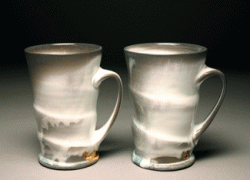

I am always fascinated with the highly conceptual and things that are strange to normal culture. One thing that I love is the misunderstood. I found this artist on DeviantArt but he is a surrealist artist from Ukraine. He uses a combination of both studio art and photoshop to create startling and equally stunning images. What I thoroughly enjoy about his cynical and slightly morbid art is the fact that his uses an alternative idea of propaganda and portraying a message that is wrong with society. As with any artist, there is always an intention to the painting, whether or not it is evident is another story however, Adnrey captures the audience with he intense imagery and then uses the attention to translate a message. 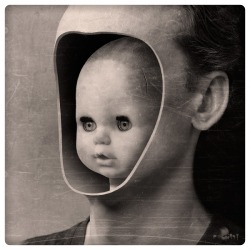 CORE
This is my favorite image my Adnrey. The reason why i like this image is beacuse it is truly haunting to look at. I think the child's face inside the adult's body protrays a strong message. It translates two things. One, we all have a child in the CORE of our being that symbolizes the innocence that we all have. Second, the image also translates that there society builds a shell or a host body to guard and protect the child in us. The interesting part of this is interpreting the piece. If the human body is protection, then the child is actually our soul or our spirit. The other aspect that I like is the medium. The black and white color scheme gives the piece the idea of nostalgia and the tattered edges and rough background makes the piece look antique. Do we all have a core or are we trying to hide something?
http://adnrey.deviantart.com/art/C-O-R-E-53544792
I first came across this when talking to my friend Ruth. This is a great way to counsel people and to help them through their troubles. Ruth was telling me that through art therapy, you use ideas like the colors, the thickness of the lines, the shapes to get people to talk about their emotions and what they are thinking. Art therapy is very low key and unknown but is used in many different settings including mental health patients and people with certain brain disorders.
Art therapy is defined as a technique that is both healing and also the creative process to surface information that would otherwise be disclosed. In art therapy, there are certain scenarios that are used in order to reveal the inner thoughts of the patients: 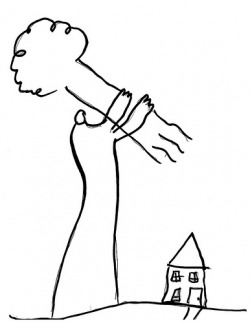 1. House-Tree-Person: for this project, the patient is asked to draw a house, a tree and a person separate from each other. After this, the therapist would begin to ask questions like “How is the weather at the house?” and “How old is the person in this picture”. This process will give hints about the inner beliefs of the patient about himself.
( http://farm4.static.flickr.com/3299/3480945074_df1f8e11d8.jpg)
 2. Road Drawing: the patient is asked to draw a road. This road is representative of the their "road of life". Therefore the parallel for this entails the trials that the patient may be under and additionally what the present circumstances are like. The most important thing to recognize in this scenario is the roads and how the bumps and mountains are.
(http://www.kids.ct.gov/kids/cwp/view.asp?a=2577&q=385820)
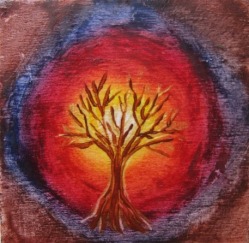 3. Diagnostic Drawing Series: this is a series of three drawings as well but uses a different approach than the House-Tree-Person scenario. First the patient is asked draw with chalk pastels anything that they want, this will express their current state of affair with their mindset and inner emotions. Then the patient is asked to draw a tree in the picture. Finally, the patient is asked to use colors, lines and shapes to express how they are feeling. Using the colors and lines used in the picture, and the placement of certain objects in the picture, the therapist can assessed the patient and try assist them in their emotions.(http://www.art-therapist.org/art_therapist_chicago05.jpg)
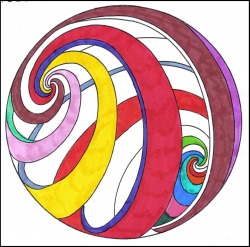 4. Mandala Assessment Research Instrument: this is a technique that stems from the Buddhist philosophy. The artist is asked to choose a card from a deck of cards. The cards have different mandalas drawn onto the cards. Then the patient is asked to choose a card from a deck of colored cards. Finally, the patient draws the mandala they have chosen using different colors with chalk pastels. The patient is then asked if there are any underlying meanings to the mandala they have drawn or the colors that they have chosen. Joan Kellogg uses the shapes, geometric patterns and colors from the mandala to assess the inner psyche of the patient.(http://www.mandalaconsulting.com/lastscan6.jpg)
One of my favorite potters is Chris Staley. What I find exceptional about his work is the use of a basic form with alterations. He also has an incredibly beautiful sense of contrast and style.
The Artist:
Here is Chris Staley's Artist Statement:
"The essence of making pots for me is about being human. It's about fragility and strength. It's about the intimate moment when the handle of a cup touches the hand.Pots are about potential.
Pots can create a world of slow time where meaning can be found.
It is a notable experience to use pots that exude the soul of the maker.
All of our senses are engaged in this experience.
Very few things can be touched and leave one a different person. It is this paradox of who is touching whom that gives pots their greatest potential.
As a young boy I often played outdoors and made things out of dirt and sticks. I struggled sitting behind a desk at school. I knew very early that to survive spiritually I had to keep creating with my hands
With technology spreading at a very increasing pace my need to feel the world seems essential." (http://www.personal.psu.edu/cxs41/statement.html)
Very well written I love how his statement has a very natural flow and rhythm to it. But I what I see can connect with is statements about the pottery being an extension from the artist. I feel that everything we do, we put a little bit of ourselves into but something that we create is different. As humans, we innately have a sense of personality and individuality that is diverse from one person to the next. Consequently, we develop a signature that we embellish on all the things that we create. For Staley, the emphasis lies largely on the ordinary and the unique contrast, color change and the over flow of the piece. For myself, I focus of the contrasting colors and textures and vessels that have an ethereal weight about them. 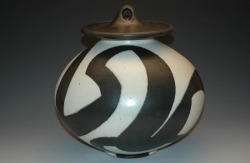 2005 18" tall Ribbon Covered Jar
I love this piece. It is like a person. The shape of the piece is beautiful and has that narrow foot ring which I personally feel is great. But what I like is how the piece can be so simple in nature and yet the surface technique can be so elegant that it transforms the piece. Additionally, I love the black and white contrast. I like that using black and white makes the piece have another dimension and takes the obvious feelings that colors exude.
In art, there are certain colors that will give off different emotions. The warm colors are colors like red, orange and yellow and bring joy, optimism and happiness. The cool colors are blue, violets and greens and bring the connotation of sadness, gloom and tranquility. But if we as artists were to take away these colors and live in black and white, how would be able to make the audience feel that same way about the piece. Staley achieves this in my mind by using the swooping thick black lines to provide the audience with movement of the eye. In turn, this gives off the idea of vibrance and activity while being able to maintain elegance.
Plainly stated, Staley is an amazing artist. I love the complexity of the concepts behind his work and the mystery that there is. I hope that art for me is about "being human".
For more on Chris Staley: http://www.personal.psu.edu/cxs41/default.html
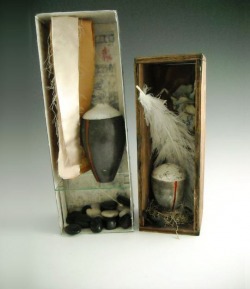 Culture: learning where I come from and what that means is a major influence in my work. Not intentionally, I have managed to show a degree of my Japanese culture in each piece I have created. My "Kimono Pots" piece demonstrates this aspect of my work most evidently. This piece references World War II and specifically the bombing of Hiroshima. The concept behind the piece was deeply rooted in my family's interactions in World War II. My dad's side of the family is from Hiroshima so this piece is close to my heart. The box on the right is representative of the destruction that occurred in Hiroshima.
Although the picture cannot show the details, there is a nest to symbolizing home, burnt wood and black flower petals to symbolize death and the wood and other miscellaneous burnt cultural memorabilia my culture. In the box is the pottery element, the raku vase with the carbon trapped lettering oxidized onto the peace. The box on the left is representative of the life after the bombing and the growth. The vase is on a glass shelf and the rocks beneath represent the "stones" that have been thrown at us but further that they are underneath our present state. Finally, the gold and tan strips of cloth show the promise for a brighter future.
The basic theme behind the piece is rising from the ashes and learning from the past. I used contextual research with Crate and Barrel and a very modern look the left box but used mundane and simple tasks to show that rebirth is possible for everyone.
Some people say that children are like having your heart separate from you, that is what my pottery is like.
 I am currently learning to play guitar. My buddy in my dorm hall is great at it and he is teaching me how to play. It is interesting how with guitar, the practice is some much different. For pottery, it was about finding a style that was appropriate for you and allowed you to master the techniques but was still very different from person to person. However, in learning to play guitar, the technique is basically the same for all people. The chords remain the same unlike learning to center, is very different. The thing that I noticed about both is that they require great rhythm. For guitar it is a bit more obvious because it is music but pottery also has a very high degree of rhythm. You can't rush or slow down either one of them.
I love music. It as well as art is a portal to another dimension where I am able to ignore the current world and surroundings and be consumed in the music and the lyrics of the song. The song that I currently trying to play is "Hallelujah" by Jeff Buckley. I hope that I will be able to play it by the end of this week. I know that chords and the lyrics but getting the rhythm correct is the hard part.
The thing that I love about being able to play music is that you can get lost in the music of a good song. I play the piano and accompany myself through that. I was thoroughly disappointed that in leaving college, I would be leaving behind my piano. However, I have discovered numerous pianos in the classrooms. I have been using those singing my heart out while playing. It is such an exhilarating feeling. I had wished that I had sung in high school or in some sort of choir but I was very apprehensive of my ability to sing. But I will be singing more now.
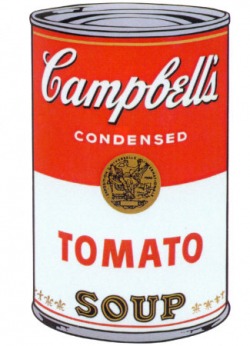 To start this, I wanted to research something that I do not have a lot of experience with. I choose Andy Warhol. This artist to me shows the progression in the mindset of the common artist. what I love about Warhol is his individuality. His work has been critiqued for being mundane, simple or plainly, not art. But what I see is the misunderstood man.
Something that I have learned recently is that you can't understand art unless you understand the context, the artist and the reason for the painting. Then you can begin to delve into the multiple layers that most art has in it. Pop art most definitely must be taken and understood in this way.
So, the Artist:
Andrew Warhola is born in Pittsburgh, PA and attended the Carniege Institute for Technology now known as the Carnegie Mellon University. There he studied pictoral design. After graduation, he moved to New York to work as illustrator for magazines such as Harper's Bizarre and Vogue and also design window collections for stores in New York City. In the 1950's Warhol became a very successful commercial artist gaining recognition and awards from both the Art Director's Club and the American Institute of Graphic Arts. Here he changed his to Andrew Warhola.In the 1960's Warhol continued his career creating some of his most memorable work the Campbell Soup Can, Marilyn Monroe and the Disasters and also creating a few films. However, he was shot in his studio that was almost fatal. In the 1970's Warhol shifted his focus on painting creating: Maos, Skulls, Hammer and Sickles. In the 1980's Warhol began his publication POPism and further created two cable television programs show casing much of his work. He died February 22, 1987after a routine gall bladder surgery. Warhol is regarded as one of the most influential artists of the 20th century. (http://warholfoundation.org/legacy/biography.html)
Knowing the background of Warhol, respect must be given to this man who was a triple threat of studio art, television and publication. He has some of the most iconic artwork of the 20th visibly recognizable. He is a true art hero being able to maintian individualism and concepts. Much of his work had undertones of the present society.
The Campbell's Soup Can in particular is representative of the society. The richest and poorest are both fed with the same soup. And that shows that the necessities to live are the same. Nothing special or different.
So I still trying to figure out the blog setting stuff.
Picture will be coming soon.
Kevin
|











 RSS Feed
RSS Feed